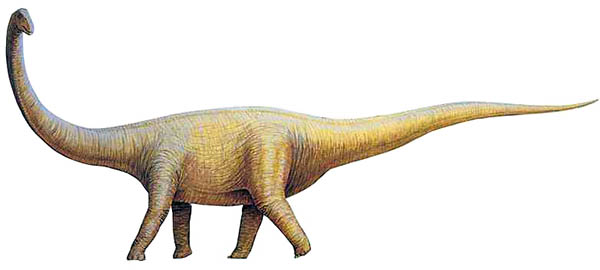
|
Search JoyZine with Google Site Search! |
Wintonotitan
For the last 75 years or so, Australia has been a relative wasteland when it comes to sauropod discoveries. That all changed in 2009, with the announcement of not one, but two new sauropod genera: Diamantinasaurus and Wintonititan, comparably sized titanosaurs represented by sparse fossil remains. Like most titanosaurs, Wintonotitan probably had a rudimentary layer of armored skin along its back, the better to deter the large, hungry theropods of its Australian ecosystem. Titanosaurs, the largest land animals known, may have reached 35m in length and 100 tonnes in weight. Wintonotitan was small for a titanosaur, at up to 15m in length and around 10-15 tonnes in weight. Wintonotitan had long front legs (its hind legs have not been found) and was relatively slim for a titanosaur. In the middle of the Cretaceous Period, 100 million years ago, Winton was a large river plain. This plain was left behind by the drying up of the inland sea known as the Eromanga Sea. There were large, winding rivers, freshwater pools, billabongs, swamps, lakes and coastal estuaries. The climate was warm and mild, with distinct seasons and plenty of rain. Huge sauropods – probably other titanosaurs – also lived in Australia at the same time. This is known from large footprints left along the Broome coastline in Western Australia. The largest of these prints is 1.5 metres across. Sauropods were plant-eaters (herbivores). The skull and teeth of Wintonotitan have not been found, so its actual diet is unknown. However, it would have been able to choose from conifers, early flowering plants, ginkgoes, cycads, ferns and horsetails. Fossils that are now known under the name Wintonotitan were first found in 1974 by Keith Watts. At the time, the specimens were assigned to an Austrosaurus sp., Austrosaurus then being the only named Australian Cretaceous sauropod genus. These fossils, catalogued as QMF 7292, consisted of a left shoulder blade, much of the forelimbs, a number of back, hip, and tail vertebrae, part of the right hip, ribs, chevrons, and unidentifiable fragments. QMF 7292 was established as the type specimen of Wintonotitan in 2009 by Scott Hocknull and colleagues. The type species is W. wattsi, honoring the original discoverer. A phylogenetic analysis found Wintonotitan to be a basal titanosauriform sauropod, in a comparable part of the titanosauriform tree to Phuwiangosaurus. QMF 7292 was found about 60km north-west of Winton, near Elderslie Station. A second specimen, QMF 10916, consisting of isolated tail vertebrae, was found at Chorregan. Both were recovered from the lower part of the Winton Formation, dated to the latest Albian. QMF 7292 was found in sandstone interpreted as a point bar of a river. Also found at the site were fish fragments, a theropod tooth, and a variety of plant fossils, including woody stems, branch impressions, cones and cone scales, and pieces of leaves. The Winton Formation had a faunal assemblage including bivalves, gastropods, insects, the lungfish Metaceratodus, turtles, the crocodilian Isisfordia, pterosaurs, and several types of dinosaurs, such as the theropod Australovenator, the sauropod Diamantinasaurus, and unnamed ankylosaurians and hypsilophodonts. Wintonotitan bones can be distinguished from Diamantinasaurus bones because Wintonotitan bones are not as robust. Wintonotitan is only distantly related to Diamantinasaurus and represents an earlier branch of the titanosaur tree. |
